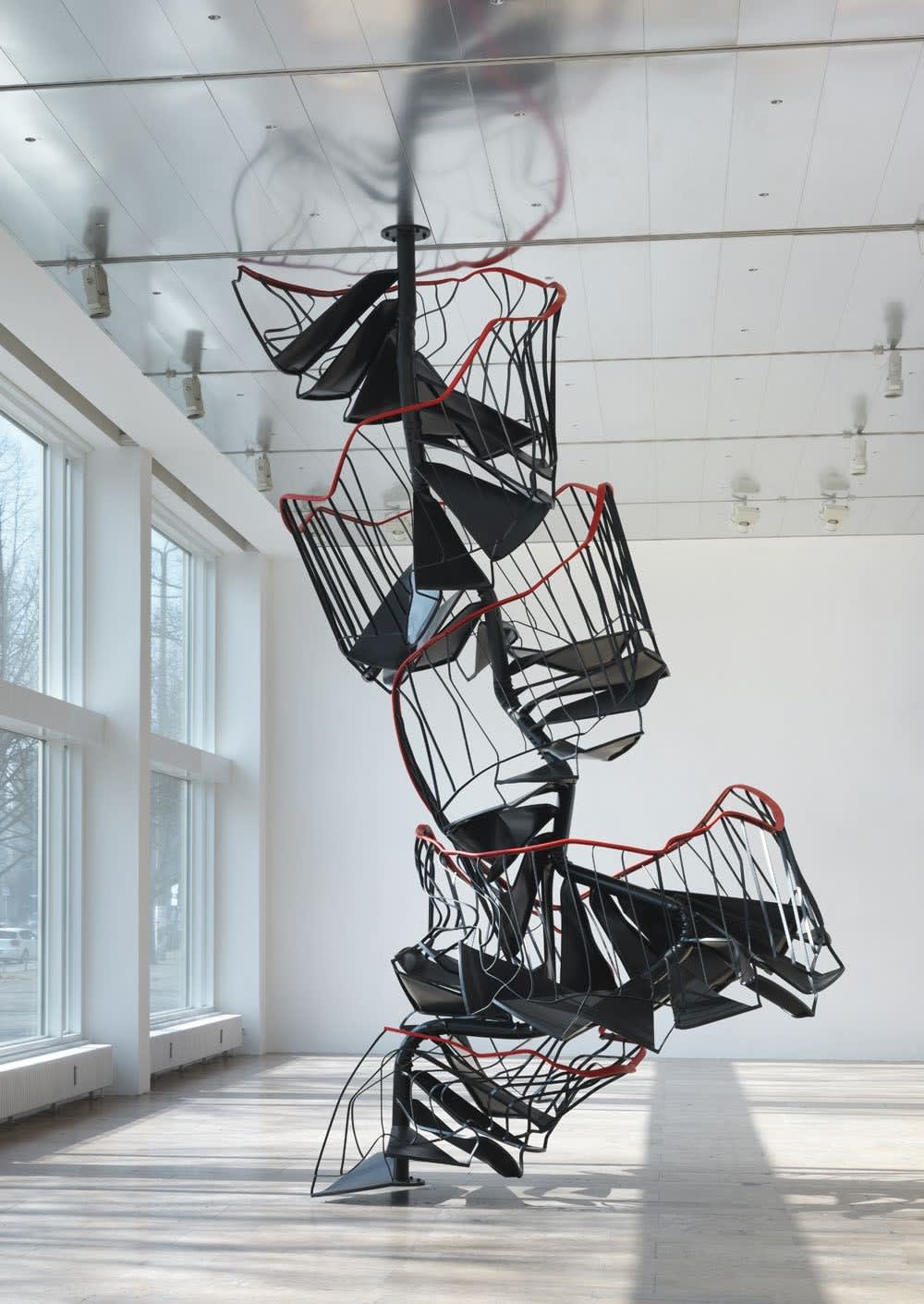Monika Sosnowska: Stairway
Capitain Petzel is pleased to present the second solo exhibition by Monika Sosnowska. The Warsaw-based artist shows the major installation “Stairway“, (2010). In an irregular serpentine shape the work is precisely suspended between ceiling and floor in the main hall of the translucent gallery space. Sosnowska conceived the work for the Herzliya Museum of Contemporary Art, Herzliya, Israel, in 2010 and adjusted it for the consecutive presentations at the Zachęta Galerie in Warsaw, Poland, (2012), the Shanghai Biennal, (2012-13) and Capitain Petzel, Berlin (2014).
Monika Sosnowska was inspired by an emergency staircase, built in 1971 at ‚The Museum of History of Tel Aviv‘, which she discovered during a residency in Israel in 2008. She documented the stairwell with a photograph, just before its deconstruction. This image creates the point of departure for her own fabricated interpretetation of the found architectural object by removing it from its original functionality through dismantling, twisting and squeezing the main elements. By changing the stairway’s direction Sosnowska challenges our perception. She captures the site, abstracts and freezes the space and creates an optical illusion leading our gaze upwards the spiral.
Important conceptual points of reference for Sosnowska are different movements and phenomena like modernist architecture primarily found in Eastern European countries, Conceptual Polish constructivism of the 1930s and Minimalism from the 1960s and 1970s. The collapsed state of the installation can be read as a response against the blind faith for once glorified ideologies of political totalitarian regimes. This disruption can also be found in Derrida’s concept of the Tower of Babel: “The ‚Tower of Babel‘ does not merely figure the irreducible multiplicity of tongues; it exhibits an incompletion, the impossibility of finishing, of totalizing, of saturating, of completing something on the order of edification, architectural construction, system and architectonics.”*
Monika Sosnowska was born in Poland in 1972 and lives and works in Warsaw. After studying at the Rijksakademie van Beeldende Kunsten in Amsterdam and the Academy of Fine Arts in Poznan she had several solo exhibitions, for example at the Serpentine Gallery, London (2004), Museum of Modern Art, New York (2006), at the 52nd Venice Biennial representing Poland in the Polish Pavillion (2007), at the Kunstmuseum Liechtenstein, Vaduz (2007), Schaulager, Basel (2008), Herzliya Museum of Contemporary Art, Israel (2010), the K21, Dusseldorf (2010-2012), Aspen Art Museum (2013) and the Australian Centre for Contemporary Art, Melbourne (2013).
* Reprinted from Jaques Derrida, „Des Tours de Babel“, translated by Joseph F. Graham, in Difference and Repetition, Copyright 1985, Cornell University Press, p. 218.
-
Capitain Petzel freut sich, die zweite Einzelausstellung von Monika Sosnowska präsentieren zu können. Die in Warschau arbeitende Künstlerin zeigt ihre raumgreifende Installation „Stairway“ von 2010. In einer unregelmäßigen, sich windenden Form ist das Werk in der zentralen Halle der lichtdurchfluteten Galerie exakt zwischen Decke und Fußboden installiert. Sosnowska hat diese Skulptur für das Herzliya Museum of Contemporary Art, Herzliya (Israel), im Jahr 2010 konzipiert und sie dann für die anschließenden Präsentationen in der Zachęta Galerie, Warschau (2012), auf der Shanghai Biennale (2012-13) und bei Capitain Petzel, Berlin (2014), jeweils an den Raum angepasst.
Den Ausgangspunkt für „Stairway“ bildet eine Aufnahme einer im Jahr 1971 eingebauten Fluchttreppe im „The Museum of History of Tel Aviv“, die sie während ihres „Artist in Residence Program“ Aufenthaltes 2008 in Israel kurz vor dessen Demontage entdeckt hat. Ihre persönliche Interpretation des vorgefundenen Objektes hebt die ursprüngliche Funktionalität der Treppe auf, da sie die zentralen Elemente verdreht und neu ausformt. Die Künstlerin fängt den Ort ein, abstrahiert den Raum, lässt ihn erstarren und erschafft eine optische Täuschung, die unseren Blick auf der Spirale nach oben führt und so unsere Wahrnehmung herausfordert.
Wichtige Bezugspunkte bilden für Sosnowska unterschiedliche Bewegungen und Phänomene wie die modernistische Architektur, vorzugsweise in den Ländern Osteuropas, der polnische Konzeptuelle Konstruktivismus der 1930er Jahre und der Minimalismus aus den 1960er and 1970er Jahren. Der „eingestürzte“ Zustand, in dem sich die Installation befindet, kann als Erwiderung auf den blinden Glauben an einstmals verherrlichte Ideologien von totalitären politischen Regimes interpretiert werden. Diese Durchbrechung lässt sich auch in Derridas Konzept des Turmbaus zu Babel finden: „Der ‚Turmbau zu Babel‘ veranschaulicht nicht nur die nicht reduzierbare Vielfalt der Sprachen; er zeigt auch die Nicht-Fertigstellung, die Unmöglichkeit, etwas zu Ende zu bringen, zusammenzufassen, zu durchdringen, zu vollenden hinsichtlich des Erbauens, des architektonischen Errichtens, des Systems und der Architektonik.“*
Monika Sosnowska wurde 1972 in Polen geboren und lebt und arbeitet in Warschau. Ihrer Ausbildung an der Rijksakademie van Beeldende Kunsten in Amsterdam und der Academy of Fine Arts in Posen folgten zahlreiche Einzelausstellungen u.a. in der Serpentine Gallery, London (2004), dem Museum of Modern Art, New York (2006), die Repräsentation Polens im Polnischen Pavillion auf der 52. Biennale in Venedig (2007), im Kunstmuseum Liechtenstein, Vaduz (2007), im Schaulager, Basel (2008), im Herzliya Museum of Contemporary Art, Israel (2010), im K21, Düsseldorf (2010-2012), im Aspen Art Museum (2013) and im Australian Centre for Contemporary Art, Melbourne (2013).
* Übersetzt aus: Reprinted from Jaques Derrida, „Des Tours de Babel“, translated by Joseph F. Graham, in Difference and Repetition, Copyright 1985, Cornell University Press, p. 218.


